Fracture Properties Evaluation of Cellulose Nanocrystals Cement Paste
Abstract
:1. Introduction
2. Experimental Investigation
2.1. Materials and Mixing Method
2.2. Compressive Strength Test
2.3. Fracture Test Setup
2.4. Hydration Process
3. Experimental Results and Discussion
3.1. Compressive Strength
3.2. Fracture Analysis
3.3. Hydration Analysis
3.4. Scanning Electron Microscopy (SEM) and Energy Dispersive X-ray Spectroscopy (EDX) Observations
4. Conclusions
- The incorporation of 0.2% and 1% CNCs increased the compressive strength by 10% and 17%, respectively.
- The addition of 0.2% CNCs led to an increase in the peak load; however, the incorporation of 1% CNC resulted in a decrease in the peak load.
- The dispersion of CNCs particles was found to be a critical factor that can significantly affect the mechanical properties.
- The addition of CNCs led to an extended dormant period, which resulted in a delay in the hydration reaction. However, the addition of CNCs led to a higher heat flow, compared to the reference sample.
- SEM and EDX results showed an enhancement in cement hydration products for 0.2% CNCs and 1% CNCs, as compared to the reference cement paste.
Author Contributions
Funding
Acknowledgments
Conflicts of Interest
List of Acronyms and Notations
| a0/D | Notch length/depth |
| CNCs | Cellulose nanocrystals |
| CNT | Carbon nanotube |
| C-S-H | Calcium silicate hydrates |
| EDX | Energy dispersive X-Ray spectroscopy |
| EVA | Poly acetate |
| Gc | Critical energy release rate |
| HPMC | Hydroxypropyl methylcellulose |
| ITZ | Interfacial transition zone (ITZ) |
| Kc | Critical stress intensity factor |
| LEFM | Linear elastic fracture mechanics |
| S/D | Span/depth ratio |
| SEM | Scanning electron microscope |
| SP | Superplasticizer |
References
- Ramezanianpour, A.A.; Esmaeili, M.; Ghahari, S.A.; Najafi, M.H. Laboratory study on the effect of polypropylene fiber on durability, and physical and mechanical characteristic of concrete for application in sleepers. Constr. Build. Mater. 2013, 44, 411–418. [Google Scholar] [CrossRef]
- Ghahari, S.A.; Ghafari, E.; Assi, L. Pore structure of cementitious material enhanced by graphitic nanomaterial: A critical review. Front. Struct. Civil Eng. 2018, 12, 137–147. [Google Scholar] [CrossRef]
- Habibi, Y.; Lucia, L.A.; Rojas, O.J. Cellulose nanocrystals: Chemistry, self-assembly, and applications. Chem. Rev. 2010, 110, 3479–3500. [Google Scholar] [CrossRef] [PubMed]
- Land, G.; Stephan, D. Preparation and application of nanoscaled C-S-H as an accelerator for cement hydration. Nanotech. Constr. 2018, 87, 73–78. [Google Scholar]
- Rocha, V.V.; Ludving, P.; Trindade, A.C.; Silva, D.A. The influence of carbon nanotubes on the fracture energy, flexural and tensile behavior of cement based composites. Constr. Build. Mater. 2019, 209, 1–8. [Google Scholar] [CrossRef]
- Hu, Y.; Luo, D.; Li, P.; Li, Q.; Sun, G. Fracture toughness enhancement of cement paste with multi-walled carbon nanotubes. Constr. Build. Mater. 2014, 70, 332–338. [Google Scholar] [CrossRef]
- Liu, J.; Fu, J.; Ni, T.; Yang, Y. Fracture toughness improvement of multi-wall carbon nanotubes/graphene sheets reinforced cement paste. Constr. Build. Mater. 2019, 200, 530–538. [Google Scholar] [CrossRef]
- Silva, D.A.; Monteiro, P.J.M. The influence of polymers on the hydration of Portland cement phases analyzed by soft X-ray transmission microscopy. Cem. Concr. Res. 2006, 36, 1501–1507. [Google Scholar] [CrossRef]
- Dousti, M.R.; Boluk, Y.; Bindiganavile, V. The effect of cellulose nanocrystal (CNC) particles on the porosity and strength development in oil well cement paste. Constr. Build. Mater. 2019, 205, 456–462. [Google Scholar] [CrossRef]
- Flores, J.; Kamali, M.; Ghahremaninezhad, A. An investigation into the properties and microstructure of cement mixtures modified with cellulose nanocrystal. Materials 2017, 10, 498. [Google Scholar] [CrossRef] [Green Version]
- Mejdoub, R.; Hammi, H.; Suñol, J.J.; Khitouni, M.; M‘nif, A.; Boufi, S. Nanofibrillated cellulose as nanoreinforcement in Portland cement: Thermal, mechanical and microstructural properties. Compos. Mater. 2016, 51, 1–13. [Google Scholar] [CrossRef]
- ASTM C1437-15. Standard Test Method for Flow of Hydraulic Cement Mortar; ASTM International: West Conshohocken, PA, USA, 2015. [Google Scholar]
- RILEM-50-FMC, Détermination de l’énergie de rupture des mortiers et bétons par flexion «trois points» de poutres encochées. Mater. Struct. 1985, 18, 280–285.
- Elices, M.; Planas, J. Fracture mechanics parameters of concrete: An overview. Adv. Cem. Based Mater. 1996, 4, 116–127. [Google Scholar] [CrossRef]
- Jenq, Y.S.; Shah, S.P. A Fracture toughness criterion for concrete. Eng. Fract. Mech. 1985, 21, 1055–1069. [Google Scholar] [CrossRef]
- Gettu, R.; Bažant, Z.P.; Karr, M.E. Fracture properties and brittleness of high strength concrete. ACI Mater. J. 1990, 7, 608–618. [Google Scholar]
- ASTM C1421-10. Standard Test Methods for Determination of Fracture Toughness of Advanced Ceramics at Ambient Temperature; ASTM International: West Conshohocken, PA, USA, 2010. [Google Scholar]
- TAM Calorimeter. Air Isothermal Calomitery. Available online: http://www.tainstruments.com/main.aspx?siteid=11&id=217&n=4 (accessed on 15 November 2018).
- Mehta, P.K.; Monteiro, P.J.M. Concrete Microstructure, Properties, and Materials; McGraw-Hill: NJ, USA, 2006. [Google Scholar]
- Sarker, P.K.; Haque, R.; Ramgolam, K.V. Fracture behavior of heat cured fly ash based geopolymer concrete. Mater. Des. 2013, 44, 580–586. [Google Scholar] [CrossRef]
- Wittmann, F. Crack formation and fracture energy of normal and high strength concrete. Sadhana 2002, 27, 413–423. [Google Scholar] [CrossRef]
- Bažant, Z.P.; Planas, J. Fracture and Size Effect in Concrete and Other Quasibrittle Materials; CRC press: Boca Raton, FL, USA, 1997. [Google Scholar]
- Bažant, Z.P. Concrete fracture models: Testing and practice. Eng. Fract. Mech. 2002, 69, 165–205. [Google Scholar] [CrossRef]
- Guinea, G.; Planas, J.; Elices, M. Measurement of the fracture energy using three-point bend tests: Part 1—Influence of experimental procedures. Mater. Struct. 1992, 25, 212–218. [Google Scholar] [CrossRef]
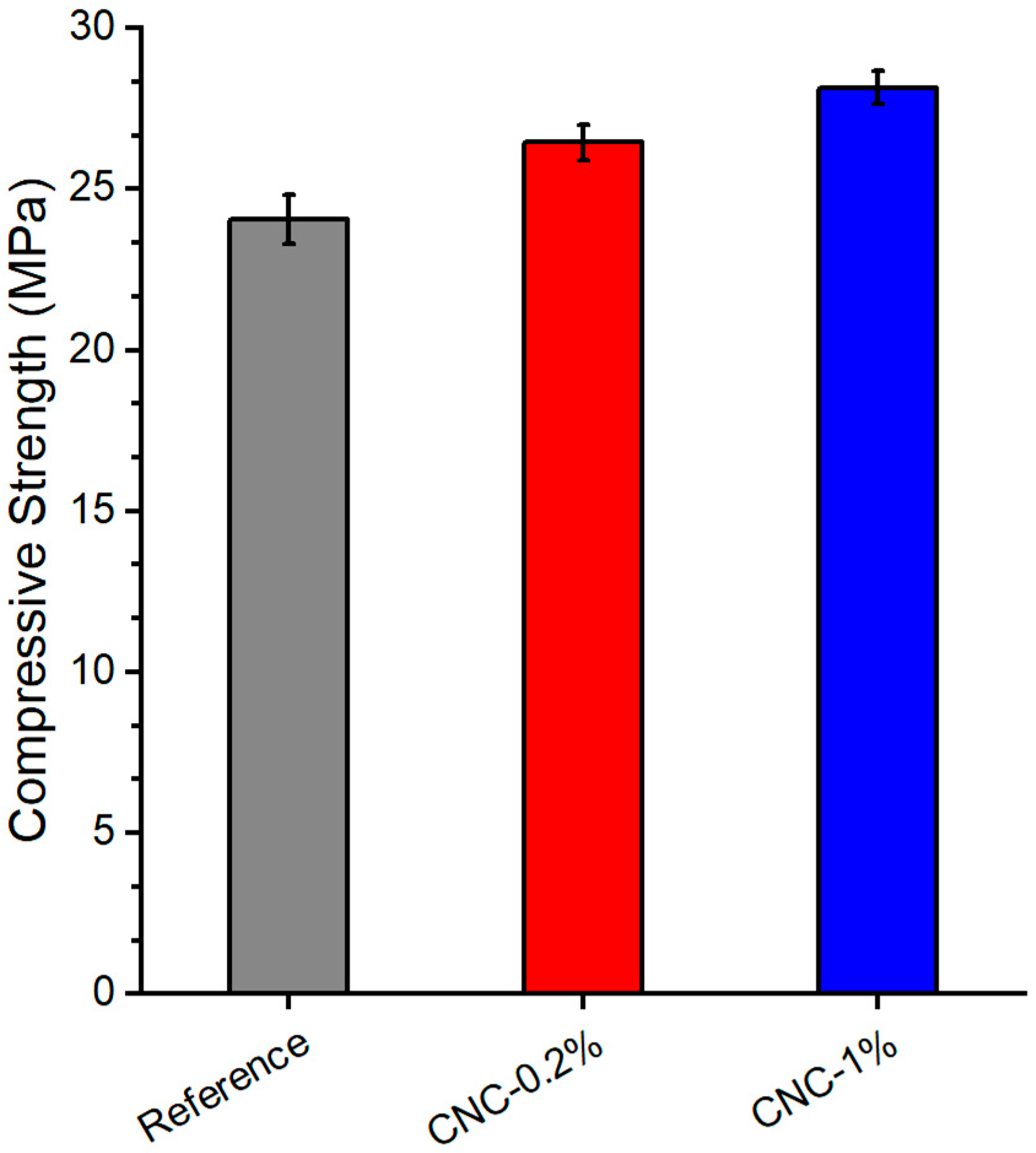

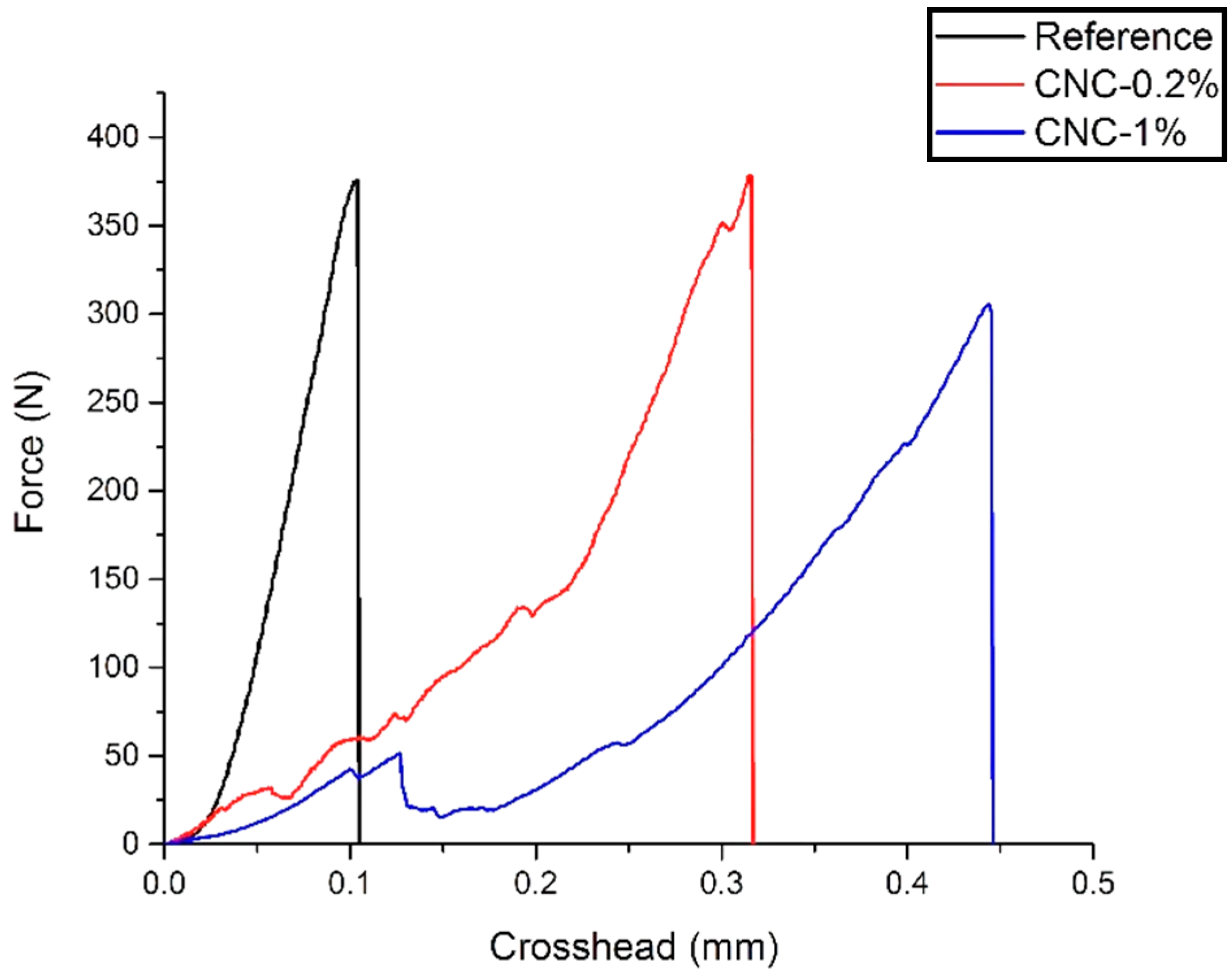
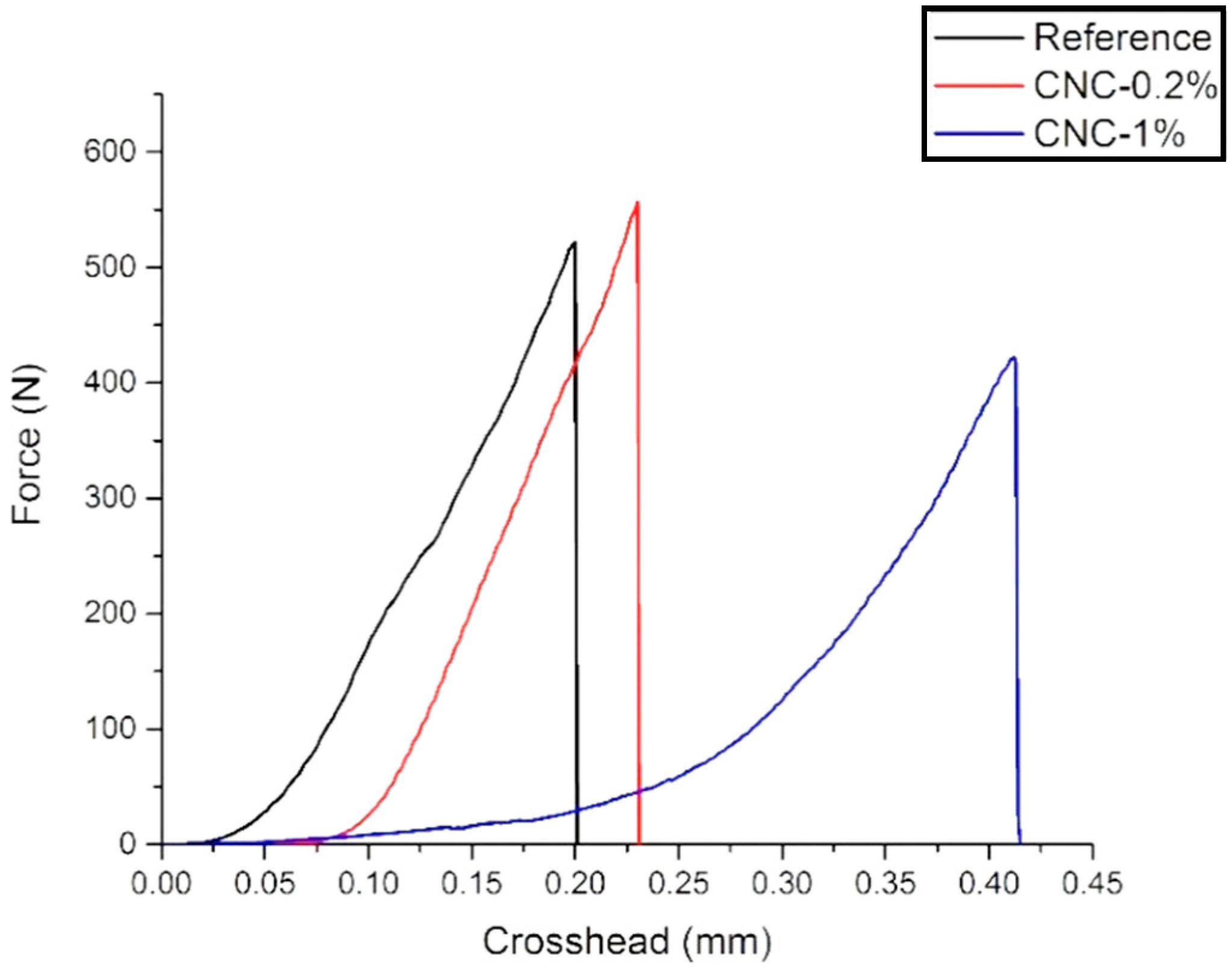
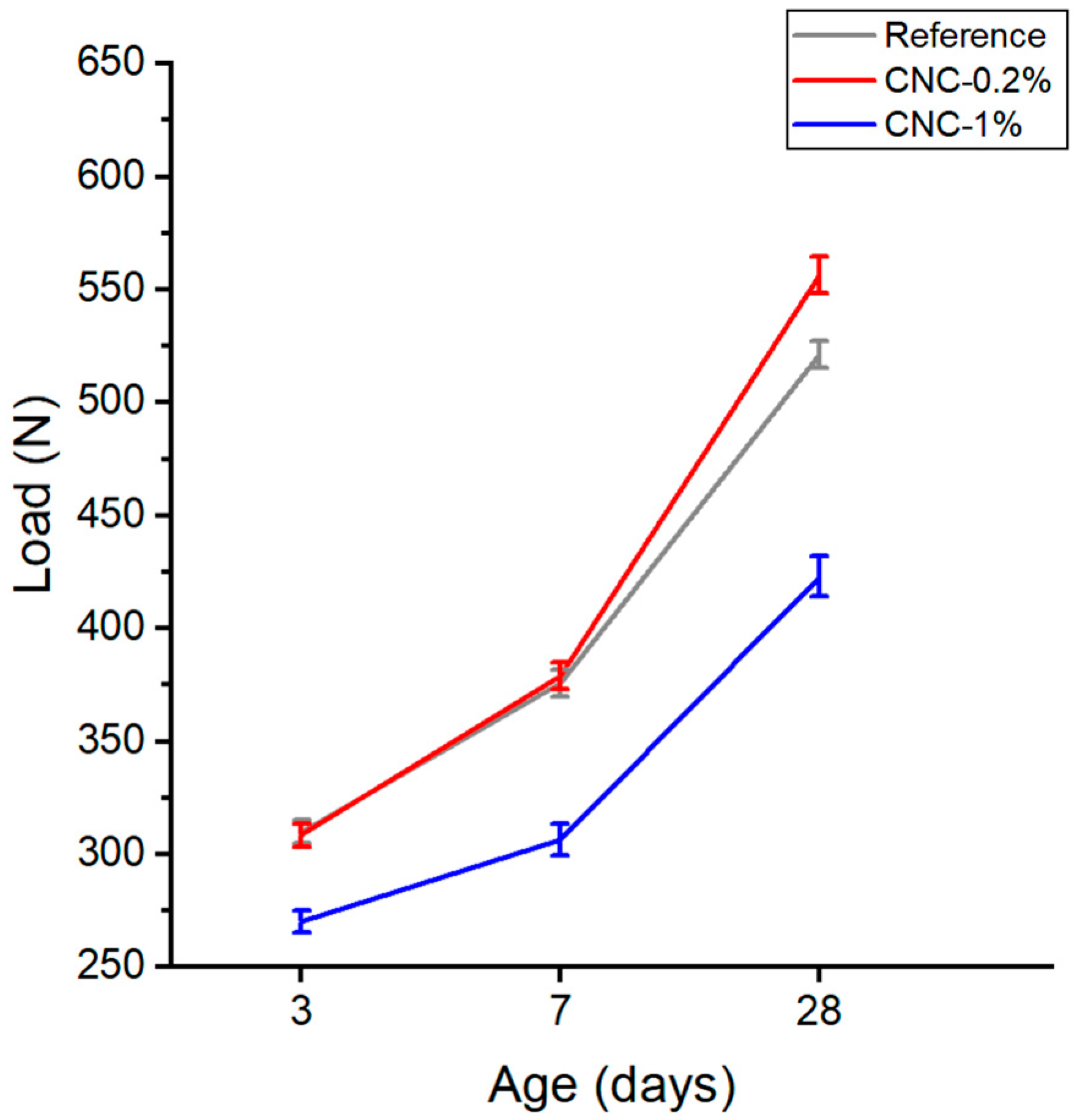
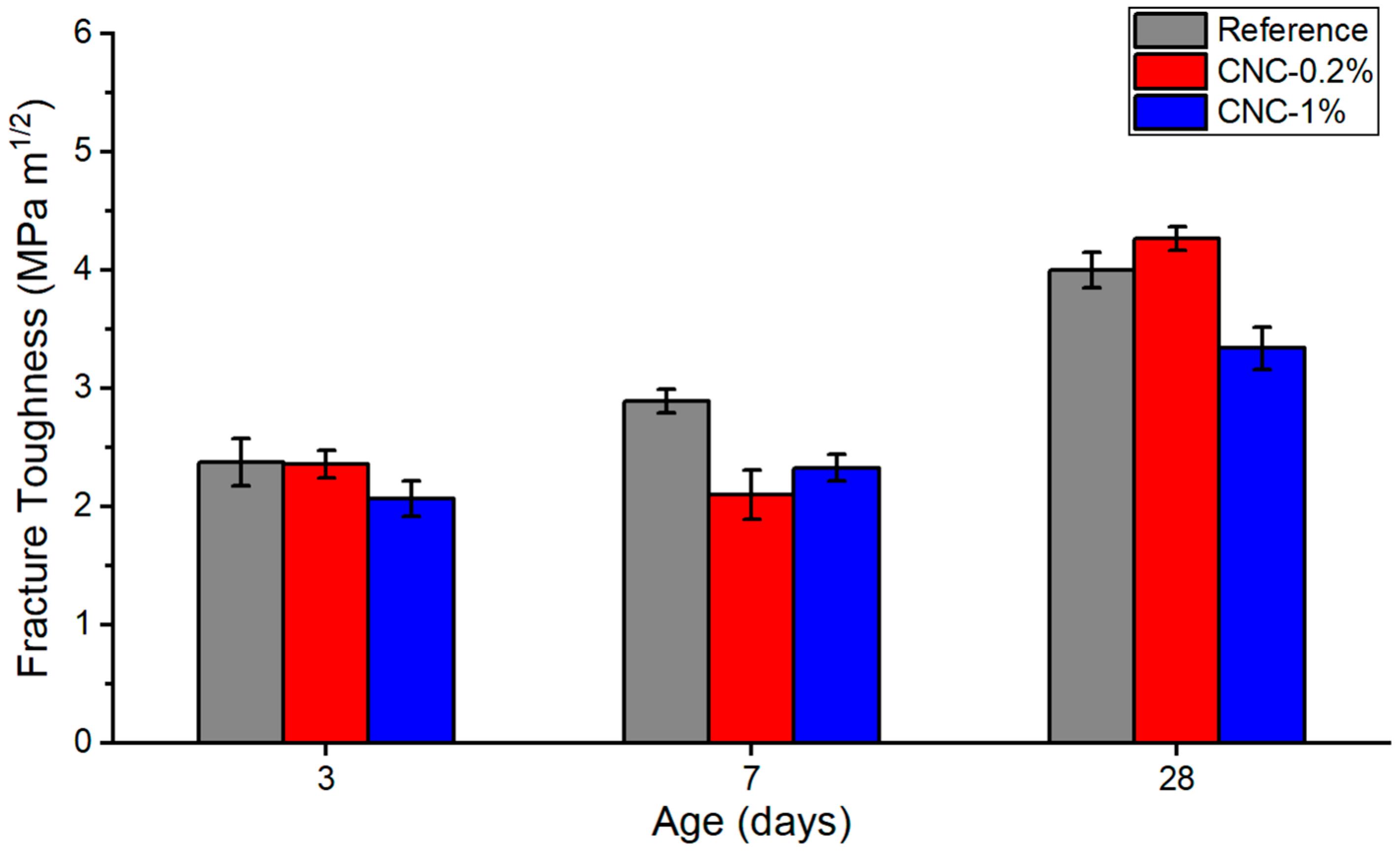
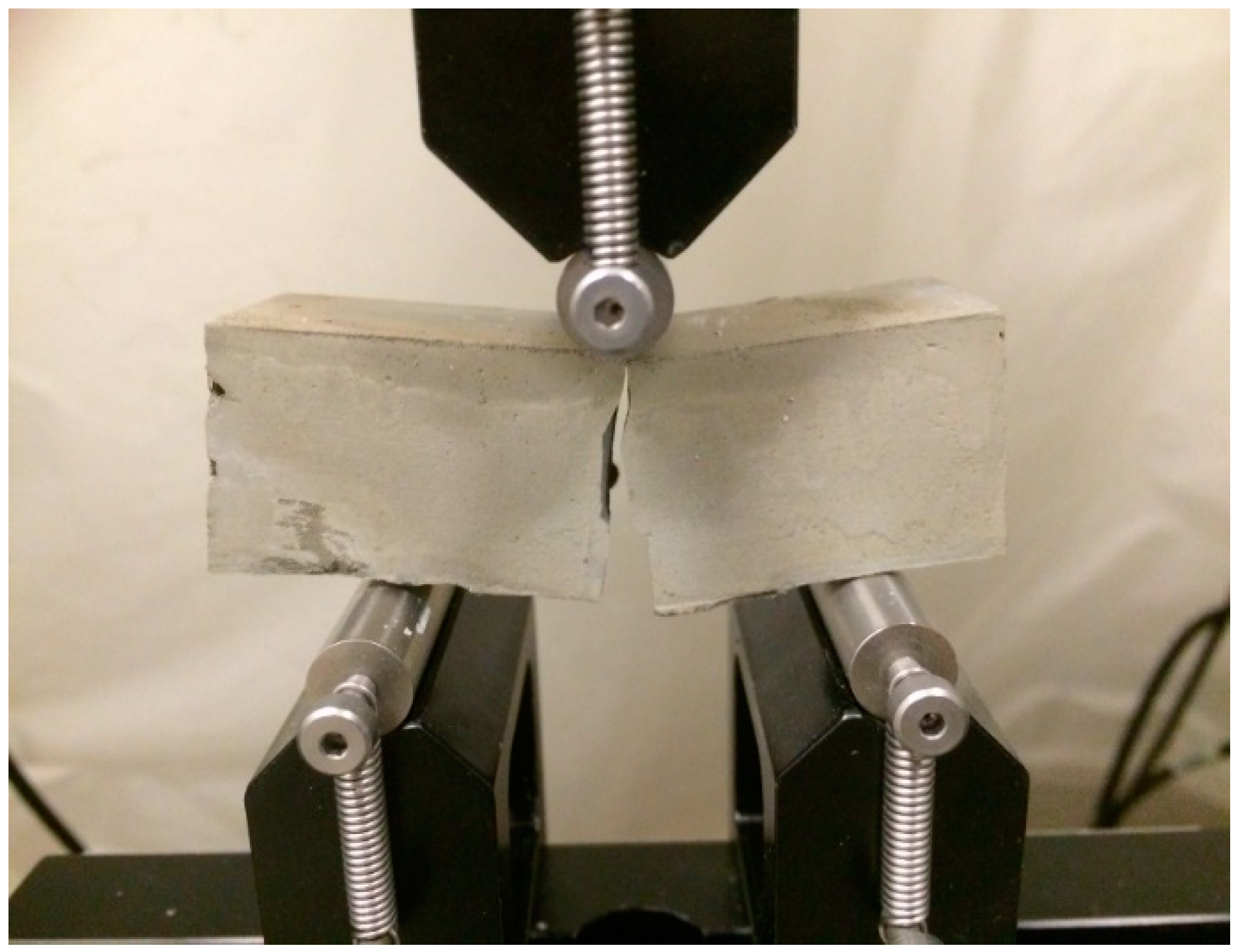
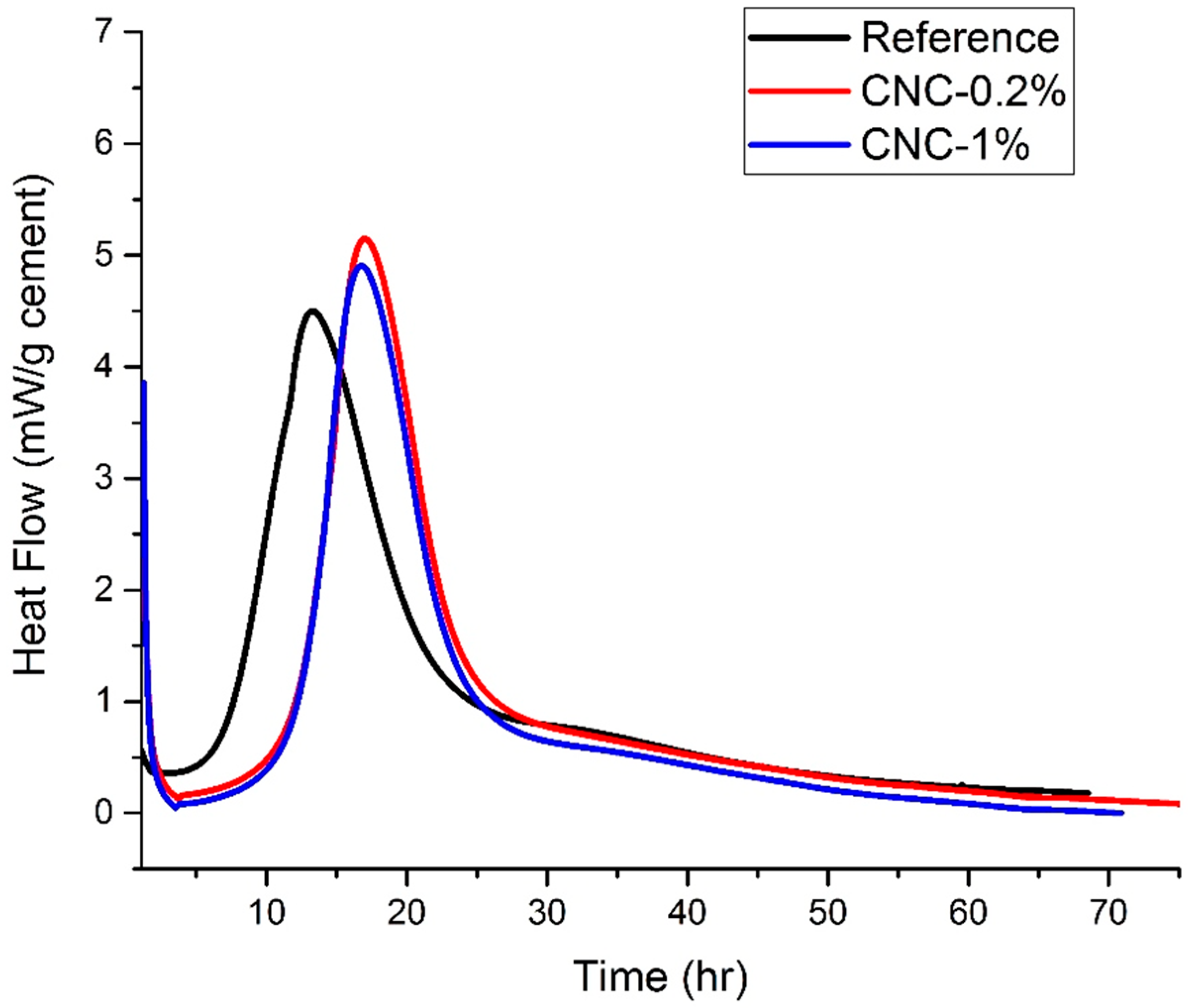

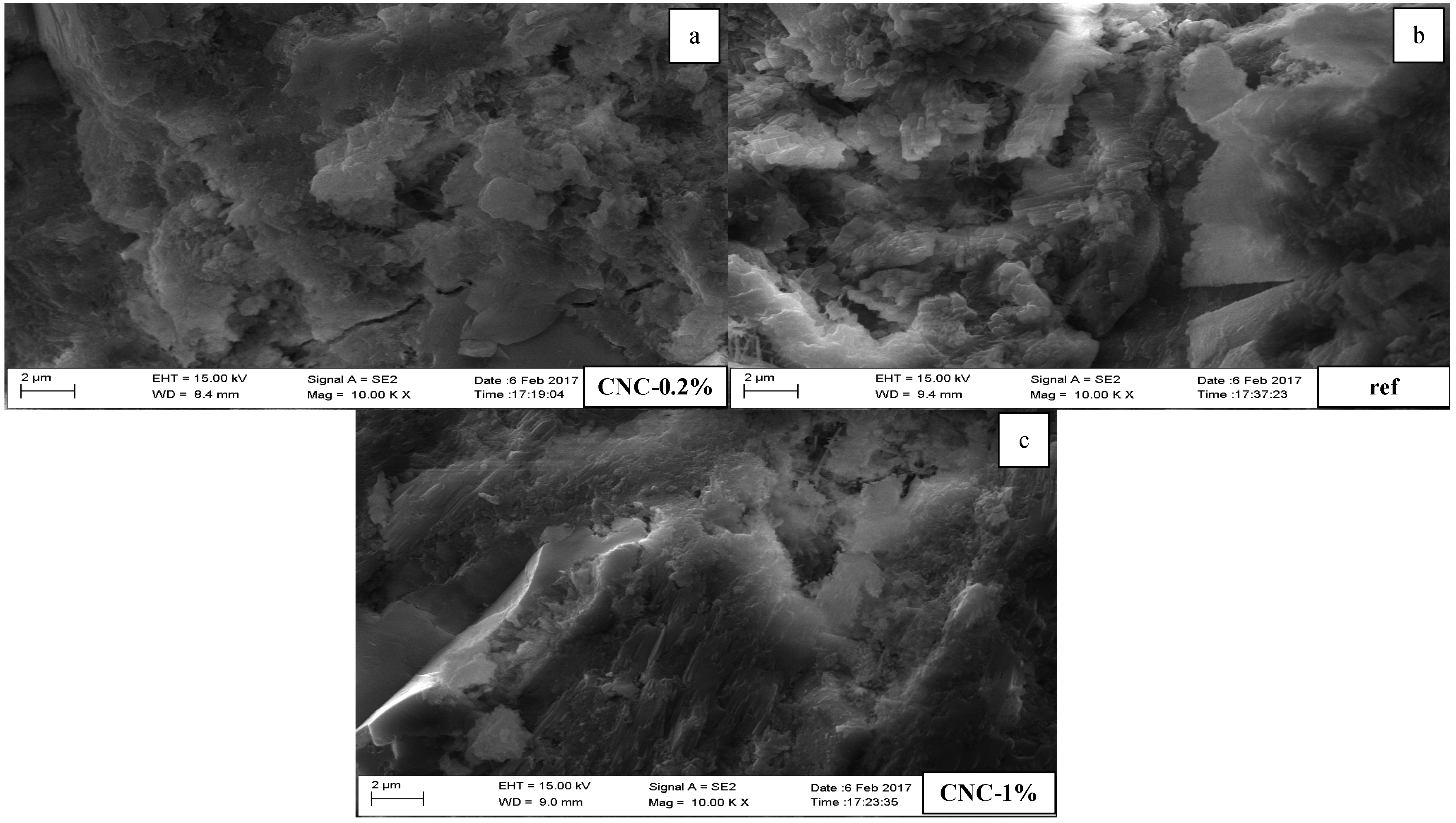
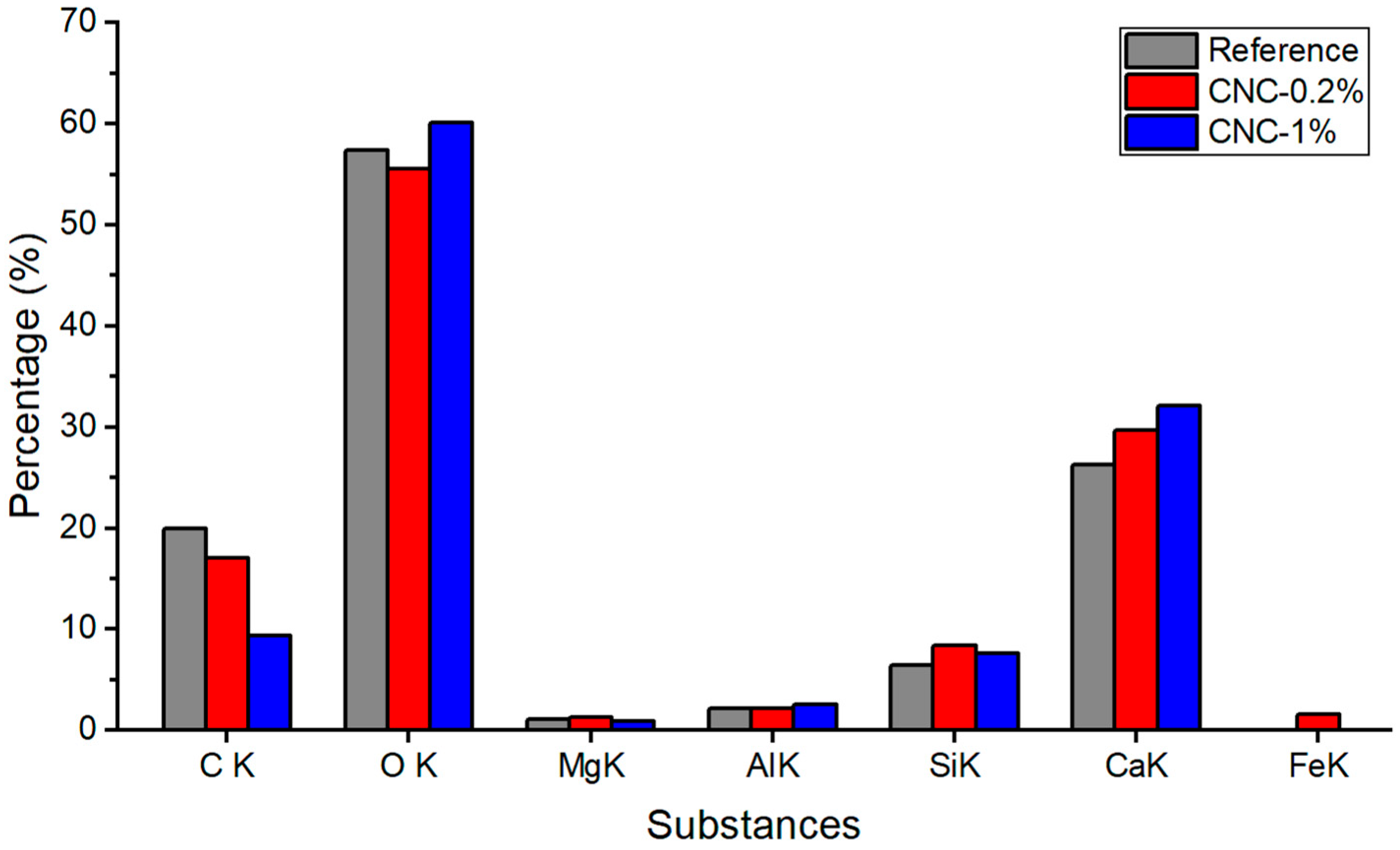
| Length (µm) | Width (nm) | ρ (g/cm3) | σf (GPa) | Cross-Section |
|---|---|---|---|---|
| 0.05–0.5 | 3–5 | 1.6 | 7.5–7.7 | Square |
| Items | Limit | Results |
|---|---|---|
| SiO2 (%) | - | 19.7 |
| Al2O3 (%) | 6.0 max | 4.5 |
| Fe2O3 (%) | 6.0 max | 3.5 |
| CaO (%) | - | 63.1 |
| MgO (%) | 6.0 max | 1.4 |
| SO3 (%) | 3.0 max | 2.9 |
| Loss on Ignition (%) | 3.5 max | 1.2 |
| Insoluble Residue (%) | 1.5 max | 0.3 |
| CO2 (%) | - | 0.5 |
| CaCO3 in limestone (%) | 70 min | 90 |
| Potential Phase Compositions | Limit | Results |
|---|---|---|
| C3S (%) | - | 60 |
| C2S (%) | - | 11 |
| C3A (%) | 8 max | 6 |
| C3AF (%) | - | 11 |
| C3S + 4.7C3A (%) | 100 max | 90 |
| Material | Reference | CNC-0.2% | CNC-1% |
|---|---|---|---|
| Cement | 589.4 | 588.2 | 583.5 |
| Water | 206.3 | 206.3 | 206.3 |
| Superplasticizer | 7 | 7 | 7 |
| CNC | 0 | 0.6 | 3 |
© 2020 by the authors. Licensee MDPI, Basel, Switzerland. This article is an open access article distributed under the terms and conditions of the Creative Commons Attribution (CC BY) license (http://creativecommons.org/licenses/by/4.0/).
Share and Cite
Ghahari, S.; Assi, L.N.; Alsalman, A.; Alyamaç, K.E. Fracture Properties Evaluation of Cellulose Nanocrystals Cement Paste. Materials 2020, 13, 2507. https://doi.org/10.3390/ma13112507
Ghahari S, Assi LN, Alsalman A, Alyamaç KE. Fracture Properties Evaluation of Cellulose Nanocrystals Cement Paste. Materials. 2020; 13(11):2507. https://doi.org/10.3390/ma13112507
Chicago/Turabian StyleGhahari, SeyedAli, Lateef N. Assi, Ali Alsalman, and Kürşat E. Alyamaç. 2020. "Fracture Properties Evaluation of Cellulose Nanocrystals Cement Paste" Materials 13, no. 11: 2507. https://doi.org/10.3390/ma13112507
APA StyleGhahari, S., Assi, L. N., Alsalman, A., & Alyamaç, K. E. (2020). Fracture Properties Evaluation of Cellulose Nanocrystals Cement Paste. Materials, 13(11), 2507. https://doi.org/10.3390/ma13112507








